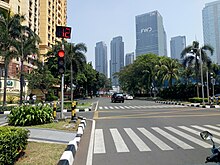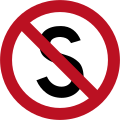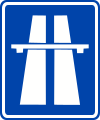Driving in Indonesia is generally not recommended due to dangerous local driving habits and the variable infrastructure, but doable with the right experience. Most foreign visitors can drive in Indonesia with a home-country-issued license of the appropriate class accompanied with an International Driving Permit (IDP).
Understand
[edit]Indonesian roads can vary from city to city, and island to island in terms of quality. This can range from the wide avenues of Jakarta and the high-speed toll roads of Java, to the narrow two-lanes on the other islands. Indonesia drives to the left, like its neighbors Malaysia and Singapore, but different from the Philippines which drives to the right.
As with most of Southeast Asia, there is a strong car culture in Indonesia, but the most common private vehicle is the motorcycle. Most Indonesian families own at least one motorcycle.
Atrocious driving is fairly the norm across Indonesia, with illegal passing, speeding, and dangerous lane changes being fairly common. Motorcyclists are fairly notorious for weaving through traffic and turning at speed, and pedestrian crossings are rarely respected. Congestion is a problem, especially in Jakarta, and the main roads in the major island (Java, Sumatra) can become congested during holiday seasons, notably during mudik or the mass exodus to the provinces for Eid al-Fitr or Lebaran.
Talk
[edit]Indonesian is the national and only official language in Indonesia. Most road signs in the country will only be written in Indonesian, and communication with law enforcement and emergency services are primarily in Indonesian. Malay speakers should not have much difficulty understanding Indonesian, except for some differences in vocabulary.
Road networks
[edit]

Major roads in Indonesia can be broadly broken down into toll roads (jalan tol), national roads (jalan nasional), provincial roads (jalan provinsi) and city/regency roads (jalan kota/kabupaten), roughly equivalent to Interstates, US Routes, state highways and county roads in the US, or M, A, B and C roads in Australia (except Western Australia).
- Toll roads (jalan tol): Tolled controlled-access highways (freeways/motorways), primarily in Java and Sumatra, where they form a network. Shorter routes exist in Bali, Kalimantan and Sulawesi, around the biggest cities. Most routes are four-lane divided highways, with some wider segments around cities. Tolls can only be paid by prepaid bank cards.
- National roads (jalan nasional): Major toll-free highways connecting major cities, usually in the larger islands. These routes are indicated by numbers in Java, Bali and Sumatra, but unnumbered in the other regions. Roads vary from winding two-lane highways in the hinterland to wide avenues in big cities like Jakarta. Notable national routes are the North Coast Road (Jalan Pantai Utara, shortened to Pantura) and the Trans-Sumatra Highway (Jalan Lintas Sumatera, also AH25).
- Other roads are provincial roads (jalan provinsi) and city/regency roads (jalan kota/kabupaten), which are maintained by local governments (provinces, cities/regencies). Quality can vary, from narrow two-lanes in the jungle to spacious urban avenues such as the Jalan Sudirman in Jakarta.
The Asian Highway network has four routes in Indonesia:
- AH2, which runs from Denpasar to Jakarta
- AH25, which follows the Trans-Sumatra Highway and parts of the partially completed Trans-Sumatra Toll Road from Bakauheni port (near Bandar Lampung) to Banda Aceh.
- AH151, which follows the Central Sumatra Highway, an alternate to Tran-Sumatra Highway between Tebing Tinggi and Bandar Lampung.
- AH152, which runs from Jakarta to Surakarta via Bandung.
Rules
[edit]Most of Indonesia's driving rules are based on Dutch rules, the key difference is Indonesia drives to the left. All measurements are in metric units only. Road signage is a mix of European and American standards.
Some key rules:
- Drive to the left. Pass other traffic to the right, and stay on the leftmost left lane on toll roads unless passing.
- Yield to traffic from the left at uncontrolled intersections.
- Seat belts mandatory for people in the front seats
- Headlights on at all times.
- Helmets mandatory on motorcycles.
- Motorcycles (including big bikes) prohibited on all toll roads. Exceptions are the Bali Mandara Toll Road and the Suramadu (Surabaya-Madura) Bridge, which allow them on physically separated roadways.
- Stopping at the shoulder except in an emergency prohibited on the shoulder/emergency lane of toll roads.
- Using a cell phone without a hands-free kit is illegal.
Licensing
[edit]Indonesian driver's licenses (surat izin mengemudi, commonly shorted to SIM) is generally provided only to Indonesian citizens and long-term residents with a valid Indonesian identity card and residency permit. Indonesia is not a party to the 1949 Geneva Convention on Road Traffic, but most foreigners can drive in Indonesia up to 90 days with an valid home-country-issued driver's license of the appropriate class along with a matching International Driving Permit (IDP). Any driving license issued by another ASEAN country is also valid in Indonesia and can be used without matching IDP.
Indonesian driver's licenses are also valid indefinitely in ASEAN member countries.
Road signs
[edit]Road signs in Indonesia are a mix of European and American designs. Warning signs are yellow and black (or orange and black in construction zones), prohibitory signs are red and white, mandatory and information signs are blue and white, directional signs are green and white, and tourist-oriented signs brown and white. Visitors from the US, Canada, Australia and much of Europe will find the signage similar to those in Latin America, Japan and New Zealand. Most signs use pictograms only, but textual signs are common, however, messages are usually only in Indonesian. One oddity visitors must watch out is with street name signage, which indicates the name of the road perpendicular to the sign, not the road parallel to the sign as in most of the world.
Messages on road signs are usually in Indonesian only, even on toll roads. Bilingual signage in Indonesian and English can be found in tourist areas. Some common messages and terms with their English translations:
- Dilarang parkir: no parking
- Hati-hati: watch out
- Keluar: exit (on toll roads)
- Kurangi kecepatan: reduce speed
- Sampai rambu berikut: until next sign
- School zone ahead.
- No overtaking/passing. Similar signage is used in China and Japan.
- No stopping. Similar signage is used in Australia and South Africa
- Toll road begins.
- U-turn location
- Street name sign. Name on sign is for the road ahead, not the intersecting road
Road markings
[edit]Indonesia uses yellow for lines separating traffic in different directions, and white lines for lines separating traffic in the same direction. Broken lines means passing/overtaking or lane changes is permitted. Unbroken lines indicate where overtaking/passing or lane changes is not permitted.
Speed limits
[edit]
Unless otherwise posted, speed limits in Indonesia is at 30 km/h (19 mph) on residential roads, 50 km/h (31 mph) on urban roads, 80 km/h (50 mph) on rural roads and 100 km/h (62 mph) on toll roads. Speed limits are indicated by a red circle, with the speed on red numerals and followed by km (in superscript) on the right, similar to the pre-1960s speed limit signage of several European countries. There is zero tolerance for speeding, but enforcement is spotty.
Traffic lights
[edit]
Indonesian traffic lights (lampu lalu lintas) are usually placed overhead at the stop line, like in Europe, and people from countries where the main traffic lights are placed across the intersection (e.g. United States, Canada, Malaysia, Philippines, China) must watch out. Left turns on red (and turns on red between two one-way street) are illegal in Indonesia. Intersections may have an advance stop line for motorcyclists. Traffic lights may have timers indicating the remaining time for each phase. Red lights usually turn red-and-amber phase seconds before turning green, much as in Europe.
Rental
[edit]Renting a car in Indonesia is cheap, starting at $125/day. While it is possible to rent a car yourself, it is generally recommended to rent a car with driver.
City driving
[edit]Driving in Indonesian cities is particularly a hassle. Many Indonesian cities have narrow, winding inner streets shared with bicycles and pedestrians. Jakarta is infamous for traffic congestion, with long-lasting traffic jams (macet). Consider taking public transport or taxis to get around cities.
Fuel
[edit]Fuel prices are relatively cheap in Indonesia, and sold by the liter. Full-service gasoline stations (pom bensin or SPBU in Indonesian) are the norm in Indonesia: expect an attendant for payment and service.
The most common gas station chain is state-owned Pertamina, which sells gasoline at subsidized prices. For example, it costs a fixed Rp8,750/L for octane 88 fuel, and no more than Rp10,000 for other types.
Stay safe
[edit]- See also: Indonesia#Stay safe
The national emergency hotline in Indonesia is 112.
Night driving in Indonesia can be dangerous, as lighting may be lacking and some cars may be driving without their headlights.
Be particularly careful with motorcycles, especially in the cities, as deaths from motorcycle crashes are common in Indonesia. Do watch out for them when changing lanes or turning (even if you use turn signals).
Traffic enforcement in Indonesia generally falls under the Indonesian National Police (Polri)'s traffic unit (Satuan Lalu Lintas or Satlantas), identifiable with their officers in peaked caps and reflectorized vests. Corruption is a serious problem when dealing with the police. The usual fine for a minor traffic infraction is at Rp15,000.






